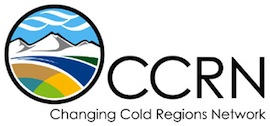
Emily Anderson
MSc student, Department of Geography/Centre for Hydrology, University of Saskatchewan (supervisors: John Pomeroy and Mike Demuth)
 (306) 966-5619
(306) 966-5619 emily.anderson@usask.ca
emily.anderson@usask.ca
Thesis Topic: Modelling Changes in Multi-Decadal Streamflow Contributions – Bologna Glacier, Selwyn Mountains, NWT
Climate warming results in glacier contraction and changes in the coverage of snow, firn, and glacier ice that impact the energy balance and affect the timing and magnitude of streamflow generation. The impact of glacier-climate co-variability on streamflow in Canada’s northern continental regions, however, has remained undocumented. This study evaluates changes in glacier snow accumulation, energy balance, ablation, and hydrological regime with changing climate for the Bologna Glacier in the Ragged Range (Selwyn Mountains) headwaters of the South Nahanni River, NWT. The Bologna Glacier Basin was instrumented with two meteorological stations in 2014, which measured air temperature, relative humidity, precipitation, wind speed, and radiation on and off the glacier surface. These short-term observations were subsequently used to spatially and temporally downscale ECMWF Interim Re-Analysis (ERA-Interim) atmospheric reanalyses for the meteorological parameters and thereby construct a meteorological record from 1979 to 2015. The Cold Regions Hydrological Model Platform (CRHM) was used to construct a physically-based glacier hydrology model that incorporated a new glacier module: an energy balance snow and ice ablation model coupled with a blowing snow and avalanche model to characterize the mass balance of glacier snow and ice. To set up the model, the Bologna Glacier Basin was discretized into Hydrological Response Units (HRUs) representing the spatial distribution of hydrological processes, parameters, and driving meteorology. HRUs were delineated by metrics including elevation, slope, aspect, equilibrium line, and land cover type, using a digital elevation model and Landsat satellite imagery from 1982 and 2014. Reconstructed meteorological data were used to force the model to run continuously over three decades with the former (1982) and contemporary (2014) glacier geometry and equilibrium line configuration to determine the impact of climate warming, reduced glacier cover, and increased ice exposure on headwater streamflow generation.
- A short video on this research is at: https://vimeo.com/144034358
Awards and Scholarships
- W. Garfield Weston Award for Northern Research, Masters, 2015 – $15,000
- Northern Scientific Training Program, 2015 – $2500 for logistic and field support
- Canadian Geophysical Union Travel Support, 2016 – $225
- GIWS video contest, 2016 – $500 for professional development
